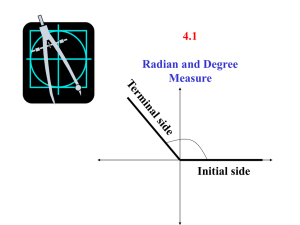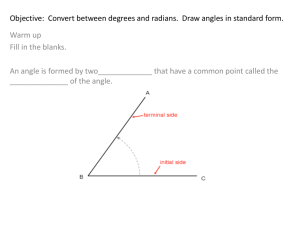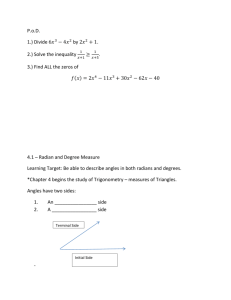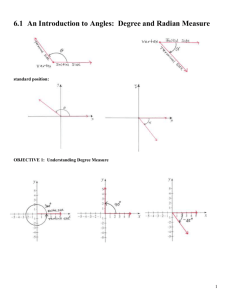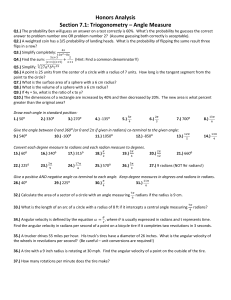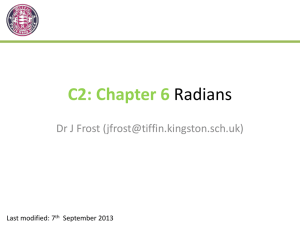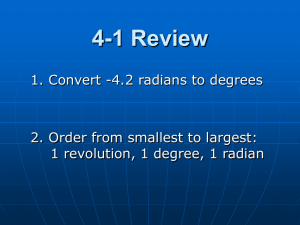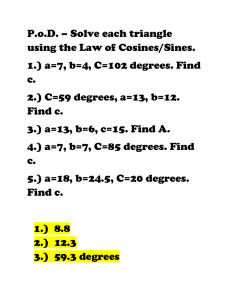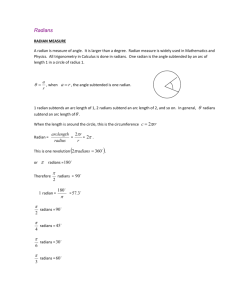4.1 Notes (Completed) - Fort Thomas Independent Schools
advertisement
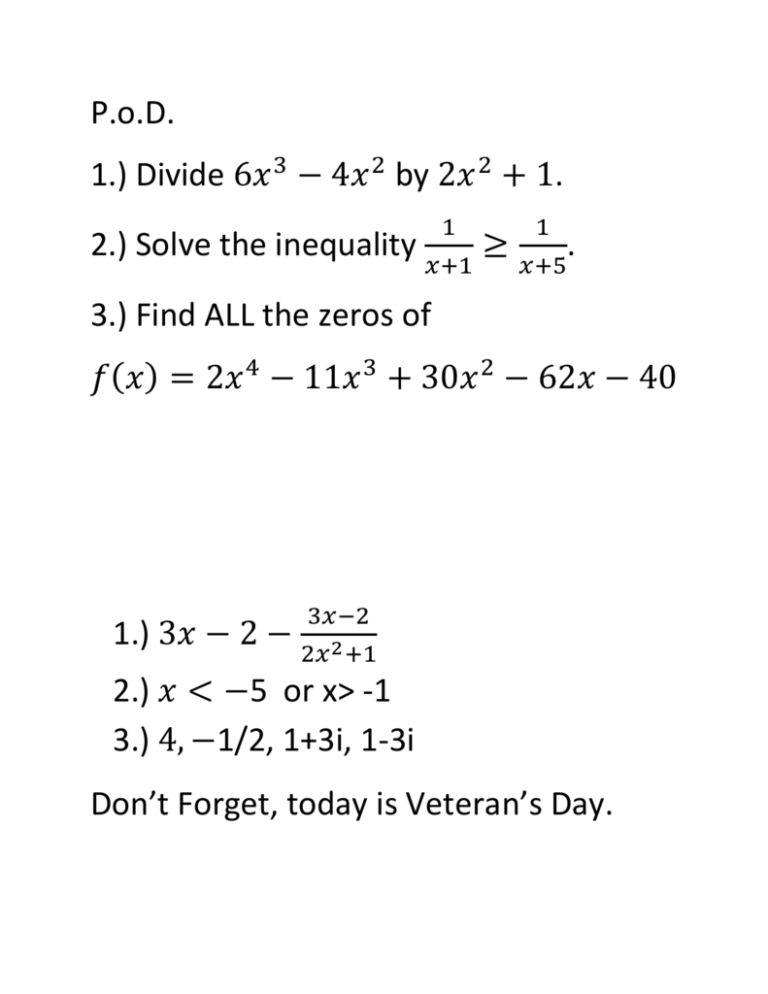
P.o.D. 1.) Divide 6𝑥 3 − 4𝑥 2 by 2𝑥 2 + 1. 2.) Solve the inequality 1 𝑥+1 ≥ 1 . 𝑥+5 3.) Find ALL the zeros of 𝑓(𝑥 ) = 2𝑥 4 − 11𝑥 3 + 30𝑥 2 − 62𝑥 − 40 1.) 3𝑥 − 2 − 3𝑥−2 2𝑥 2 +1 2.) 𝑥 < −5 or x> -1 3.) 4, −1/2, 1+3i, 1-3i Don’t Forget, today is Veteran’s Day. 4.1 – Radian and Degree Measure Learning Target: Be able to describe angles in both radians and degrees. *Chapter 4 begins the study of Trigonometry – measures of Triangles. Angles have two sides: 1. An initial side 2. A terminal side Terminal Side Initial Side - The endpoint of the two rays is known as the vertex. - An angle centered at the origin is said to be in Standard Position. - Positive angles are measured counterclockwise. - Negative angles are measure clockwise. - If two angles have the same position, then they are said to be coterminal. Radian vs. Degree: - Just as distance may be measured in feet and centimeters, angles can be measured in both radians and degrees. Definition of a Radian: 𝑠 𝜃 = , where s is the arc length and r is 𝑟 the radius. Conversion Factors: 2𝜋 𝑟𝑎𝑑𝑖𝑎𝑛𝑠 = 360° 𝜋 𝑟𝑎𝑑𝑖𝑎𝑛𝑠 = 180° 1 𝑟𝑎𝑑𝑖𝑎𝑛 ≈ 57.3° Some Other Common Radian Measures: 𝜋 45° = 𝑟𝑎𝑑𝑖𝑎𝑛𝑠 4 𝜋 60° = 𝑟𝑎𝑑𝑖𝑎𝑛𝑠 3 𝜋 30° = 𝑟𝑎𝑑𝑖𝑎𝑛𝑠 6 𝜋 90° = 𝑟𝑎𝑑𝑖𝑎𝑛𝑠 2 Acute Angles are between 0 and radians. 𝜋 2 𝜋 Obtuse Angles are between and 𝜋 2 radians. EX: For the positive angle 9𝜋 4 subtract 2𝜋 to obtain a coterminal angle. 9𝜋 9𝜋 8𝜋 𝜋 − 2𝜋 = − = 4 4 4 4 EX: For the positive angle 5𝜋 6 subtract 2𝜋 to obtain a coterminal angle. 5𝜋 5𝜋 12𝜋 7𝜋 − 2𝜋 = − =− 6 6 6 6 EX: For the negative angle − 3𝜋 4 , add 2𝜋 to find a coterminal angle. 3𝜋 −3𝜋 8𝜋 5𝜋 − + 2𝜋 = + = 4 4 4 4 Recall your Quadrants for Geometry: In Q1 0 < 𝜃 < In Q2 𝜋 2 3𝜋 2 2 <𝜃<𝜋 In Q3 𝜋 < 𝜃 < In Q4 𝜋 3𝜋 2 < 𝜃 < 2𝜋 Complementary – two angles whose 𝜋 sum is radians or 90 degrees. 2 Supplementary – two angles whose sum is 𝜋 radians or 180 degrees. EX: Find the complement and 𝜋 supplement of . 6 Complement: 𝜋 𝜋 3𝜋 𝜋 − = − 2 6 6 6 2𝜋 𝜋 = = 6 3 Supplement: 𝜋 6𝜋 𝜋 𝜋− = − 6 6 6 5𝜋 = 6 EX: Find the complement and supplement of 5𝜋 6 . Complement: 𝜋 5𝜋 − = 2 6 3𝜋 5𝜋 − = 6 6 −2𝜋 −𝜋 = 6 3 Since the angle is negative, no complement exists. Supplement: 5𝜋 𝜋− 6 6𝜋 5𝜋 = − 6 6 𝜋 = 6 *There are 360 degrees in a circle. Conversions Between Degrees and Radians: 1. To convert degrees to radians, multiply degrees by 𝜋 . 180 2. To convert radians to degrees, multiply radians by 180 𝜋 . EX: Convert 60 degrees to radians in terms of pi. 60° 𝜋 𝑟𝑎𝑑𝑖𝑎𝑛𝑠 × = 1 180° 60𝜋 180 𝜋 = 𝑟𝑎𝑑𝑖𝑎𝑛𝑠 3 EX: Convert 320 degrees to radians in terms of pi. 320 𝜋 × 1 180 320𝜋 = 180 16𝜋 = 𝑟𝑎𝑑𝑖𝑎𝑛𝑠 9 EX: Convert -30 degrees to radians in terms of pi. −30 𝜋 × 1 180 −30𝜋 = 180 −𝜋 = 𝑟𝑎𝑑𝑖𝑎𝑛𝑠 6 *We could write this as a positive angle. −𝜋 −𝜋 12𝜋 + 2𝜋 = + 6 6 6 11𝜋 = 𝑟𝑎𝑑𝑖𝑎𝑛𝑠 6 𝜋 EX: Express as a degree measure. 6 𝜋 180 × 6 𝜋 180 = 6 = 30° EX: Express 5𝜋 3 as a degree measure. 5𝜋 180 × 3 𝜋 900 = 3 = 300° EX: Express 3 radians as a degree measure. 3 𝑟𝑎𝑑 180° × 1 𝜋 𝑟𝑎𝑑 540 = 𝑑𝑒𝑔𝑟𝑒𝑒𝑠 𝜋 ≈ 171.887° *We could also have done 3(57.3) = 171.9° *Let’s write a calculator program to convert radians to degrees and vice versa. Recall: 𝜃 = 𝑠 𝑟 Arc Length: 𝑠 = 𝑟𝜃, where r is the radius and theta is the measure of the central angle. - It is important to note that theta must always be in radians when used in a formula. EX: A circle has a radius of 27 inches. Find the length of the arc intercepted by a central angle of 160 degrees. First, convert 160 degrees to radian measure. 160° 𝜋 × 1 180° 160𝜋 = 180 8𝜋 = 9 Next, apply the formula for arc length, 𝑠 = 𝑟𝜃. 8𝜋 𝑠 = 27 ( ) 9 = 24𝜋 ≈ 75.398 𝑖𝑛𝑐ℎ𝑒𝑠 Linear Speed (v): Linear Speed v = 𝑎𝑟𝑐 𝑙𝑒𝑛𝑔𝑡ℎ 𝑡𝑖𝑚𝑒 = 𝑠 𝑡 Angular Speed 𝜔 (omega): 𝑐ℎ𝑎𝑛𝑔𝑒 𝑖𝑛 𝑡ℎ𝑒 𝑐𝑒𝑛𝑡𝑟𝑎𝑙 𝑎𝑛𝑔𝑙𝑒 𝜃 𝜔= = 𝑡𝑖𝑚𝑒 𝑡 *Study and memorize the tan box in the lower left hand corner of page 287. EX: The second hand of a clock is 8 centimeters long. Find the linear speed of the tip of this second hand as it passes around the clock face. We first need to find the distance (arc length) traveled by the second hand as it makes one complete revolution. 𝑠 = 𝑟𝜃 = 8(2𝜋) = 16𝜋 Now find its linear speed. 𝑠 16𝜋 𝑣= = 𝑡 60 𝑠𝑒𝑐𝑜𝑛𝑑𝑠 4𝜋 𝑐𝑚 ⁄𝑠 = 15 ≈ 0.8378 𝑐𝑚/𝑠 EX: The circular blade on a saw rotates at 2400 revolutions per minute. Find the angular speed in radians per second. We can use a process known as dimensional analysis. 2400 𝑟𝑒𝑣 2𝜋 𝑟𝑎𝑑 1 𝑚𝑖𝑛 × × 1 𝑚𝑖𝑛 1 𝑟𝑒𝑣 60 𝑠𝑒𝑐 4800𝜋 𝑟𝑎𝑑 = 60 𝑠𝑒𝑐 = 80𝜋 𝑟𝑎𝑑/𝑠𝑒𝑐 EX: Referring to the previous problem, the blade has a radius of 4 inches. Find the linear speed of a blade tip in inches per second. Linear Velocity is Angular Velocity multiplied by Radius, 𝑣 = 𝜔𝑟 𝑣 = 80𝜋(4) = 320𝜋 ≈ 1005.3096 𝑖𝑛/𝑠𝑒𝑐 Area of a Sector: 1 2 𝐴= 𝑟 𝜃 2 EX: A sprinkler on a golf course is set to spray water over a distance of 75 feet and rotates through an angle of 135 degrees. Find the area of the fairway watered by the sprinkler. Let’s first draw a picture of the situation. 135° 𝜋 𝑟𝑎𝑑 𝜃= × 1 180° 3𝜋 = 𝑟𝑎𝑑. 4 1 3𝜋 2 𝐴 = (75) ( ) 2 4 16875𝜋 = 8 ≈ 6626.797 𝑠𝑞𝑢𝑎𝑟𝑒 𝑓𝑒𝑒𝑡 *Let’s write a calculator program to find the area of a sector. Upon completion of this lesson, you should be able to: 1. Convert from radians to degrees and vice versa. 2. Find the supplement and/or complement of an angle. 3. Find the arc length of a sector. 4. Compute linear and angular speed. 5. Find the area of a sector. For more information, visit http://academics.utep.edu/Portals/1788/CALCULUS%20 MATERIAL/4_1%20RADIAN%20N%20DEGREES%20MEAS URES.pdf HW Pg.290 6-90 6ths, 102, 106, 117120.
